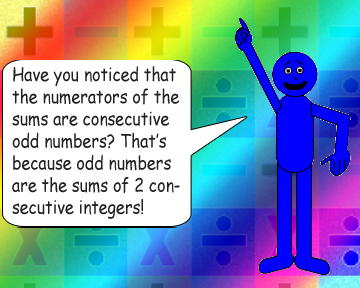
| Fraction #1 | Fraction #2 | Sum |
|---|---|---|
| 1/2 | 1/3 | 5/6 |
| 1/3 | 1/4 | 7/12 |
| 1/4 | 1/5 | 9/20 |
| 1/5 | 1/6 | 11/30 |
| 1/6 | 1/7 | 13/42 |
| 1/7 | 1/8 | 15/56 |
| 1/8 | 1/9 | 17/72 |
| 1/9 | 1/10 | 19/90 |
| 1/x | 1/(x+1) | (2x+1)/(x^2+x) |
| Fraction #1 | Fraction #2 | Sum |
|---|---|---|
| 1/3 | 1/2 | 5/6 |
| 1/4 | 1/3 | 7/12 |
| 1/5 | 1/4 | 9/20 |
| 1/6 | 1/5 | 11/30 |
| 1/7 | 1/6 | 13/42 |
| 1/8 | 1/7 | 15/56 |
| 1/9 | 1/8 | 17/72 |
| 1/10 | 1/9 | 19/90 |
| 1/(x+1) | 1/x | (2x+1)/(x^2+x) |

Back to Index Page Back to Math Trick Menu
© Derek Cumberbatch